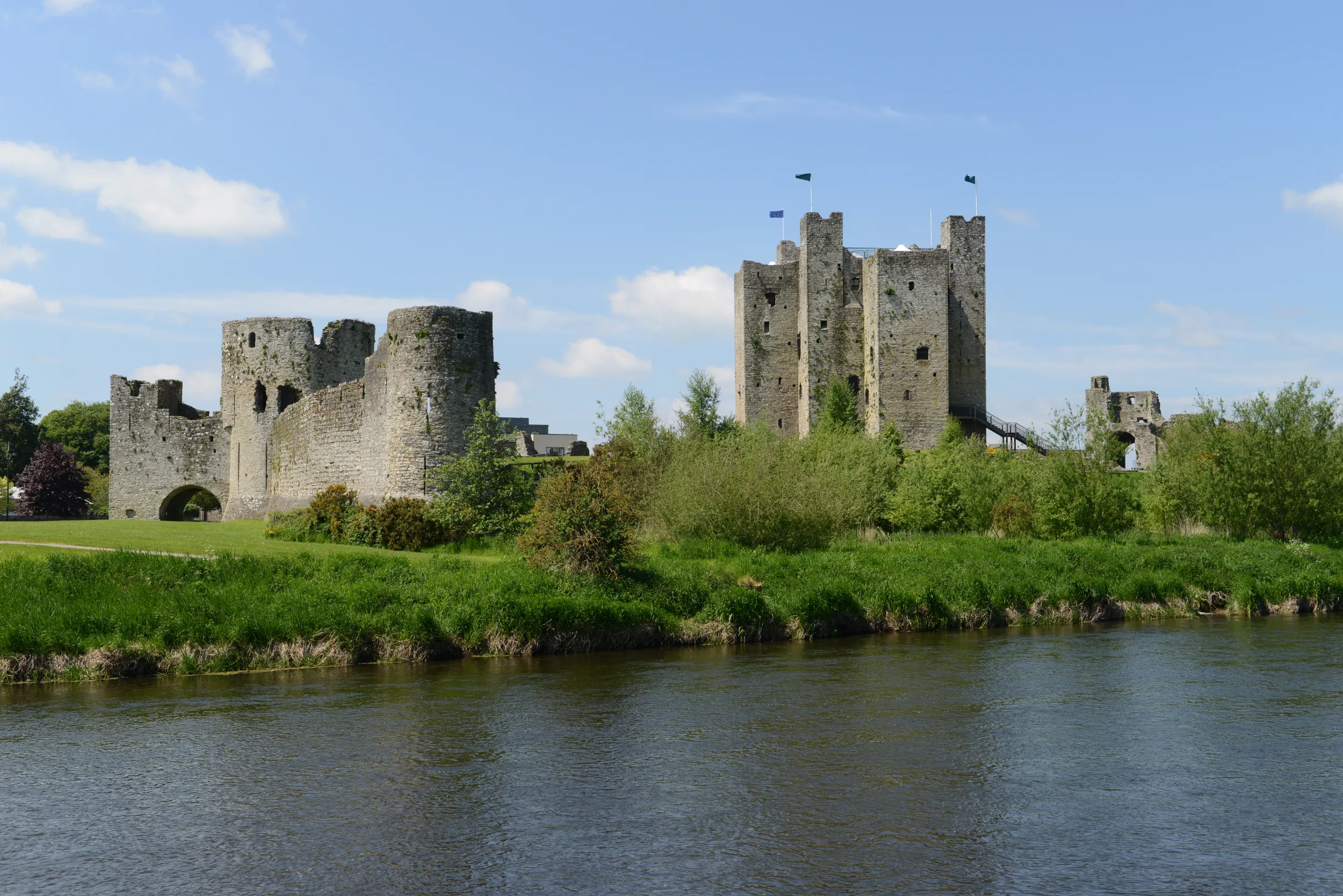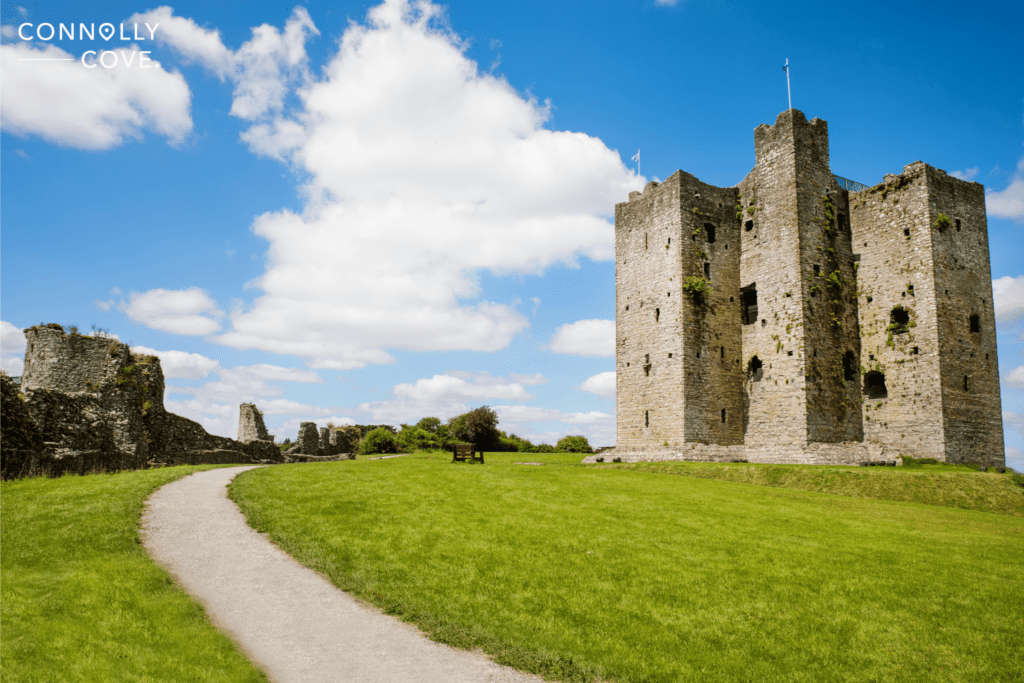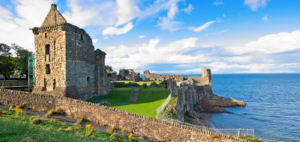Trim Castle, County Meath, Ireland

Updated On: April 17, 2024 by Ciaran Connolly
In the heart of County Meath, Ireland, stands a testament to the country’s rich medieval history: Trim Castle. This formidable fortress, with its imposing towers and sprawling grounds, holds within its walls stories of conquest, power struggles, and the resilience of the human spirit. As one of the largest Norman castles in Ireland, Trim Castle is not just a monument of stone and mortar but a living embodiment of the past, inviting visitors to delve into its mysteries and uncover the secrets hidden within its ancient walls.
A Glimpse into Medieval Ireland
Trim Castle’s story begins in the late 12th century, during a tumultuous period in Ireland’s history. Following the Norman invasion of 1169, King Henry II of England sought to consolidate his control over the island by granting vast swathes of land to his most loyal followers. Among these beneficiaries was Hugh de Lacy, a Norman nobleman appointed as Lord of Meath, tasked with asserting English authority over the region.
In 1172, de Lacy commenced the construction of Trim Castle on a strategic site overlooking the River Boyne. The castle’s design was ambitious, featuring a massive stone keep, a curtain wall encircling the inner bailey, and a series of formidable towers. Its primary function was to serve as a military stronghold, protecting the Anglo-Norman settlers from potential Irish uprisings and securing the borders of the Pale, the English-controlled territory surrounding Dublin.
Over the centuries, Trim Castle witnessed numerous conflicts and changes of ownership. It played a crucial role in the power struggles between the Anglo-Norman lords, the Gaelic Irish chieftains, and later, the English crown. Despite facing several sieges and skirmishes, the castle remained a symbol of Norman authority in Ireland, its walls standing as a testament to the resilience of its occupants.
In the 16th and 17th centuries, Trim Castle fell into decline, its strategic significance waning as the political landscape of Ireland shifted. By the 18th century, it had been largely abandoned and decayed amidst the encroaching wilderness. It wasn’t until the 19th century that efforts were made to preserve the castle, spurred by a growing interest in Ireland’s medieval heritage.
Unraveling the Mysteries of Medieval Ireland
Trim Castle’s architecture reflects the military innovations of the Norman period, characterized by its imposing stone walls, sturdy towers, and strategic layout. The central feature of the castle is its keep, a massive three-story tower that served as the residence and administrative centre of the lord and his household. Constructed from local limestone and sandstone, the keep is a formidable structure, its walls measuring up to three meters thick in some places.
Surrounding the keep is the inner bailey, an enclosed courtyard protected by a curtain wall flanked by several towers. Access to the inner bailey was controlled by a single gatehouse equipped with portcullises and murder holes to repel would-be attackers. Beyond the inner bailey lies the outer ward, a sprawling area that once housed additional domestic buildings, stables, and gardens.
One of the most distinctive features of Trim Castle is its double-moat system, comprising an inner and outer ditch separated by an earthen rampart. This ingenious defensive measure made it exceedingly difficult for assailants to breach the castle’s walls, as any approach would be met with a barrage of arrows and projectiles from above.
Despite centuries of neglect and partial demolition, much of Trim Castle’s original structure remains intact, thanks in part to restoration efforts undertaken in the 20th century. Today, visitors to the castle can explore its halls and chambers, climb its towers, and imagine themselves transported back to a time of knights, nobles, and medieval intrigue.
A Centre of Power and Influence
Throughout history, Trim Castle played a central role in Ireland’s political and military affairs. As the seat of the Lordship of Meath, it served as the administrative hub for the Anglo-Norman rulers of the region. From here, the lords of Trim exercised control over vast estates, collected taxes, and dispensed justice to the local populace.
Trim Castle witnessed its fair share of conflict and intrigue over the centuries. During the Norman invasion of Ireland, it was besieged and captured multiple times by rival factions vying for control of the region. The castle’s stout defences withstood numerous assaults, earning it a fearsome reputation among would-be attackers.
In addition to its military significance, Trim Castle symbolised wealth and power. Its impressive architecture and luxurious furnishings reflected the prestige and luxury of its inhabitants. The castle was a fortress and a residence fit for royalty, with lavish chambers, banquet halls, and gardens.
Legends and Lore

Like any ancient fortress, Trim Castle is steeped in legend and folklore, with tales of ghostly apparitions, hidden treasure, and tragic romance abounding. One of the most enduring legends is that of the “Yellow Steeple,” a towering nearby that is said to have once been part of St. Mary’s Abbey, a medieval monastery.
According to local lore, a wealthy merchant initially built the Yellow Steeple as a gift to his beloved, a nun who resided in the abbey. However, their forbidden love was discovered, and in a fit of rage, the merchant set fire to the monastery, destroying it in the process. Today, it is said that the nun’s ghost still haunts the ruins, wandering the grounds in search of her lost love.
Another famous tale associated with Trim Castle is that of the “Trim Castle Treasure,” a mythical hoard of gold and jewels said to be hidden somewhere within the castle’s walls. According to legend, the treasure was buried by the castle’s last lord, who feared it would fall into enemy hands during a siege. Despite numerous attempts to locate it, the treasure has never been found, leading some to believe that supernatural forces guard it.
Cultural Significance
Beyond its architectural significance, Trim Castle holds immense cultural importance for the people of Ireland. It serves as a tangible link to the country’s medieval past, offering insights into the lives of the ruling elite and the common folk who lived and worked within its walls.
The castle has also played a prominent role in popular culture, serving as a filming location for several movies and television shows. Most notably, Trim Castle featured prominently in the production of the film “Braveheart,” directed by Mel Gibson, where it stood in for the city of York during filming.
In addition to its cinematic appearances, Trim Castle is a focal point for historical reenactments, educational programs, and cultural events celebrating Ireland’s rich heritage. Visitors can participate in guided tours, medieval banquets, and other activities that bring the castle’s storied past to life.
For the local community, Trim Castle is more than just a tourist attraction; it is a source of pride and identity. The castle serves as a reminder of the resilience and determination of those who built and defended it throughout the ages, embodying the spirit of Irish heritage and tradition.
Visiting Trim Castle
Today, Trim Castle is one of Ireland’s premier tourist attractions, drawing visitors worldwide to marvel at its medieval splendour and explore its storied past. Guided tours are available year-round, allowing visitors to learn about the castle’s history, architecture, and inhabitants from knowledgeable guides.
Highlights of a visit to Trim Castle include climbing the keep’s spiral staircase to enjoy panoramic views of the surrounding countryside, exploring the castle’s interior chambers, and walking along the battlements to imagine life as a medieval defender. The castle grounds also offer ample opportunities for strolls and picnics, with scenic views of the River Boyne and the surrounding countryside.
In addition to touring the castle, visitors to Trim can explore the charming town that grew up around it, with its quaint shops, traditional pubs, and welcoming atmosphere. Nearby attractions include St. Mary’s Abbey ruins, the Yellow Steeple, and the scenic Boyne Valley, home to many historical and archaeological sites.
Whether you’re a history enthusiast, a lover of legends, or simply someone looking to immerse yourself in the beauty of Ireland’s countryside, visiting Trim Castle will leave a lasting impression. As you wander its ancient halls and gaze out across the landscape, you can’t help but feel a sense of awe and wonder at the enduring legacy of this magnificent medieval fortress.
While these stories may be steeped in myth and speculation, they enrich the experience of visiting Trim Castle, adding an element of mystery and intrigue to an already fascinating historical site.
Conclusion
Trim Castle is a timeless symbol of Ireland’s medieval legacy, a testament to the ingenuity and craftsmanship of its builders. From its imposing walls to its intricate fortifications, the castle invites visitors to journey through time, exploring centuries of history and heritage.
As one of Ireland’s finest examples of Anglo-Norman architecture, Trim Castle inspires awe and admiration, drawing visitors from far and wide to marvel at its grandeur. Whether exploring its ancient corridors, scaling its towering battlements, or simply soaking in the atmosphere of its surroundings, a visit to Trim Castle is an unforgettable experience that brings the past to life in vivid detail.
In an ever-changing world, Trim Castle stands as a beacon of stability and continuity, reminding us of the enduring power of history to shape our lives and inspire future generations. As we gaze upon its weathered stones and towering turrets, we are reminded of the countless stories and struggles that have unfolded within its walls, leaving an indelible mark on the landscape of Ireland and the hearts of all who visit.
Have you ever visited Trim Castle? Any other castles in Ireland (North or South) that you enjoyed visiting? We would love to hear all about it 🙂
Also, check out some of our other blogs that might interest you; Dundrum Castle, Dunguaire Castle, Legendary Castle in Ireland, Carrickfergus Castle, The Historic Castle Saunderson, Book of Kells, Enniskillen Castle Museum.






